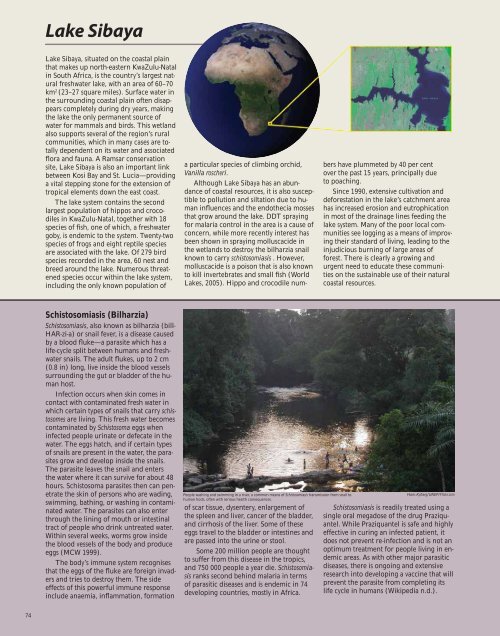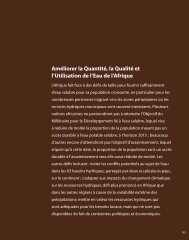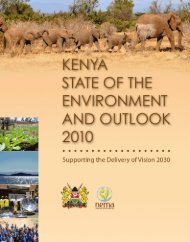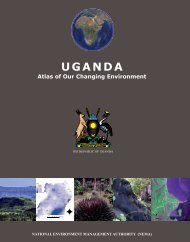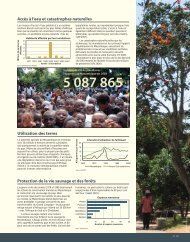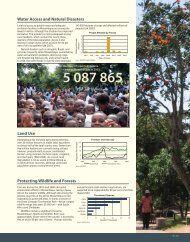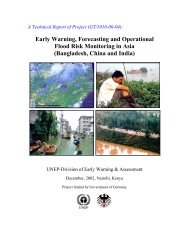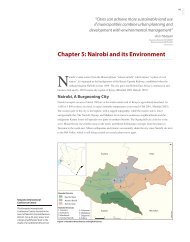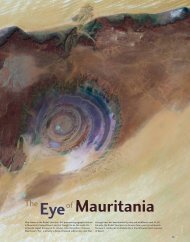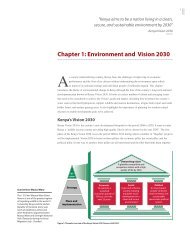LAKE SIBAYA
LAKE SIBAYA
LAKE SIBAYA
Create successful ePaper yourself
Turn your PDF publications into a flip-book with our unique Google optimized e-Paper software.
74<br />
Lake Sibaya<br />
Lake Sibaya, situated on the coastal plain<br />
that makes up north-eastern KwaZulu-Natal<br />
in South Africa, is the country’s largest natural<br />
freshwater lake, with an area of 60–70<br />
km2 (23–27 square miles). Surface water in<br />
the surrounding coastal plain often disappears<br />
completely during dry years, making<br />
the lake the only permanent source of<br />
water for mammals and birds. This wetland<br />
also supports several of the region’s rural<br />
communities, which in many cases are totally<br />
dependent on its water and associated<br />
fl ora and fauna. A Ramsar conservation<br />
site, Lake Sibaya is also an important link<br />
between Kosi Bay and St. Lucia—providing<br />
a vital stepping stone for the extension of<br />
tropical elements down the east coast.<br />
The lake system contains the second<br />
largest population of hippos and crocodiles<br />
in KwaZulu-Natal, together with 18<br />
species of fi sh, one of which, a freshwater<br />
goby, is endemic to the system. Twenty-two<br />
species of frogs and eight reptile species<br />
are associated with the lake. Of 279 bird<br />
species recorded in the area, 60 nest and<br />
breed around the lake. Numerous threatened<br />
species occur within the lake system,<br />
including the only known population of<br />
Schistosomiasis (Bilharzia)<br />
Schistosomiasis, also known as bilharzia (bill-<br />
HAR-zi-a) or snail fever, is a disease caused<br />
by a blood fl uke—a parasite which has a<br />
life-cycle split between humans and freshwater<br />
snails. The adult fl ukes, up to 2 cm<br />
(0.8 in) long, live inside the blood vessels<br />
surrounding the gut or bladder of the human<br />
host.<br />
Infection occurs when skin comes in<br />
contact with contaminated fresh water in<br />
which certain types of snails that carry schistosomes<br />
are living. This fresh water becomes<br />
contaminated by Schistosoma eggs when<br />
infected people urinate or defecate in the<br />
water. The eggs hatch, and if certain types<br />
of snails are present in the water, the parasites<br />
grow and develop inside the snails.<br />
The parasite leaves the snail and enters<br />
the water where it can survive for about 48<br />
hours. Schistosoma parasites then can penetrate<br />
the skin of persons who are wading,<br />
swimming, bathing, or washing in contaminated<br />
water. The parasites can also enter<br />
through the lining of mouth or intestinal<br />
tract of people who drink untreated water.<br />
Within several weeks, worms grow inside<br />
the blood vessels of the body and produce<br />
eggs (MCW 1999).<br />
The body’s immune system recognises<br />
that the eggs of the fl uke are foreign invaders<br />
and tries to destroy them. The side<br />
effects of this powerful immune response<br />
include anaemia, infl ammation, formation<br />
a particular species of climbing orchid,<br />
Vanilla roscheri.<br />
Although Lake Sibaya has an abundance<br />
of coastal resources, it is also susceptible<br />
to pollution and siltation due to human<br />
infl uences and the endothecia mosses<br />
that grow around the lake. DDT spraying<br />
for malaria control in the area is a cause of<br />
concern, while more recently interest has<br />
been shown in spraying molluscacide in<br />
the wetlands to destroy the bilharzia snail<br />
known to carry schistosomiasis . However,<br />
molluscacide is a poison that is also known<br />
to kill invertebrates and small fi sh (World<br />
Lakes, 2005). Hippo and crocodile num-<br />
People washing and swimming in a river, a common means of Schistosomiasis transmission from snail to<br />
human hosts, often with serious health consequences.<br />
of scar tissue, dysentery, enlargement of<br />
the spleen and liver, cancer of the bladder,<br />
and cirrhosis of the liver. Some of these<br />
eggs travel to the bladder or intestines and<br />
are passed into the urine or stool.<br />
Some 200 million people are thought<br />
to suffer from this disease in the tropics,<br />
and 750 000 people a year die. Schistosomiasis<br />
ranks second behind malaria in terms<br />
of parasitic diseases and is endemic in 74<br />
developing countries, mostly in Africa.<br />
bers have plummeted by 40 per cent<br />
over the past 15 years, principally due<br />
to poaching.<br />
Since 1990, extensive cultivation and<br />
deforestation in the lake’s catchment area<br />
has increased erosion and eutrophication<br />
in most of the drainage lines feeding the<br />
lake system. Many of the poor local communities<br />
see logging as a means of improving<br />
their standard of living, leading to the<br />
injudicious burning of large areas of<br />
forest. There is clearly a growing and<br />
urgent need to educate these communities<br />
on the sustainable use of their natural<br />
coastal resources.<br />
Hans Kylberg/UNEP/Flickr.com<br />
Schistosomiasis is readily treated using a<br />
single oral megadose of the drug Praziquantel.<br />
While Praziquantel is safe and highly<br />
effective in curing an infected patient, it<br />
does not prevent re-infection and is not an<br />
optimum treatment for people living in endemic<br />
areas. As with other major parasitic<br />
diseases, there is ongoing and extensive<br />
research into developing a vaccine that will<br />
prevent the parasite from completing its<br />
life cycle in humans (Wikipedia n.d.).


